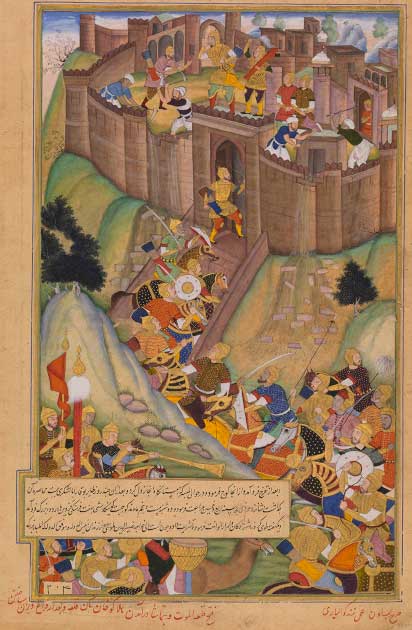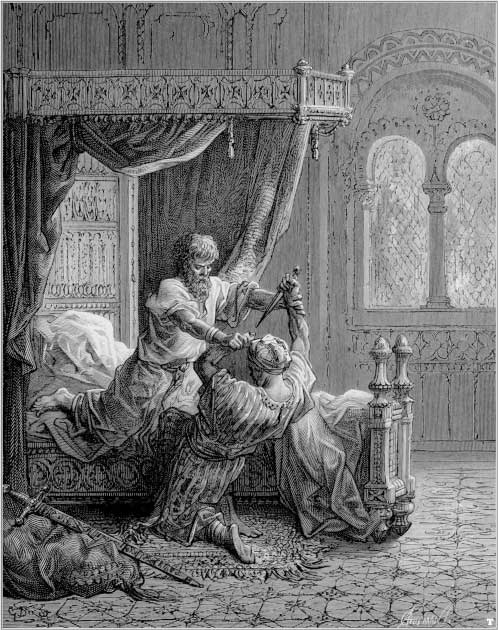The Notorious Hashshashins, the Original Assassins of Persia
When it comes to legends, none is quite as moviesque as that of the Hashshashins, who in the Middle Ages inspired fear in the hearts of leaders in the Middle East. Hassan-i Sabbah, dubbed the Old Man of the Mountain by none other than Marco Polo, was the leader of an order of Nizari Isma’ilis in the late 11th century. These were the notorious Hashshashins, who created a network of mountain fortresses and posed a threat to Sunni Seljuk authority in Persia. Perhaps the Hashshashin were most famous for the way they got rid of their opponents – through highly-skilled assassinations. In fact, the word “assassin” is said to have originated with the Hashshashin.

Hassan-i Sabbah, the radical Isma’ili missionary and brainchild behind the Hashshashins, depicted in Marco Polo’s Livre des merveilles. (Public domain)
The Complex Background of the Fabled Hashshashins
Although there are many stories about the Hashshashin, it is rather difficult to separate fact from fiction. For a start, much of the historic evidence regarding the Hashshashin has come either from European sources or people who were hostile towards them.
- Deadly Strategies and Ruthless Tactics of the Ancient Assassins
- History of Assassins: When Human Hunter-Killers Began Hunting Humans
The story of the Hashshashins goes back to the original schism in Islam which took place in 632 AD. At the time Muslims argued over who would succeed the Prophet Muhammad as their leader, which caused a divide between the Shiites and Sunnis. The Nizari Isma’ili state then emerged out of Shia Islam, when another power struggle forced the followers of the Isma’ili Prince Nizar to flee into the mountains of Persia.

View of Alamut Castle in Qazvin, Iran, the base camp of the Nizari Isma’ili leader Hassan-i Sabbah and his military group known as the Hashshashins. (Alireza Javaheri / CC BY 3.0)
The radical Isma’ili missionary, by the name of Hassan-i Sabbah, on the run from Cairo for having supported Nizar, ended up founding a sub sect of Isma’ilism, known as Nizari Isma’ilism. On the hunt for a base from which to manage his missionary work, Hassan-i Sabbah set his sights on Alamut Castle in modern-day Iran. Its location was ideal, with a bird’s eye view over the surrounding valley.
With a campaign lasting about two years, which converted the people living in the surrounding areas, Hassan-i Sabbah managed to conquer the castle in 1090. Studious and dedicated to his religion, he is remembered for knowing the Qur’an by heart and for spreading Nizari Isma’ilism from his new basecamp at Alamut Castle.

Persian miniature depicting the Hashshashins fortress of Alamut in Iran. (Public domain)
He then set up strongholds within mountainous areas throughout Persia and Syria, furnished with complex water infrastructure and built to withstand sieges. Some of their remains can still be visited today, including the partially restored Alamut Castle or the Lambsar Castle in the Alburz mountains of Iran.
Hassan-i Sabbah is also remembered for having created a military group of trained fedayeen (meaning “self-sacrificers” in Arabic) fighters, known as the Order of Assassins or the Hashshashin. Severely outnumbered, the Nizari Isma’ili were hated by both the Shiite and Sunni Muslims who surrounded them on all sides. These Hashshashin became known for their deadly tactics and religious devotion, which were developed due to their hazardous situation.

An artist’s depiction of a hashshashin. (Fair Use)
Marco Polo and the “Drug-Fuelled” Hashshashins
According to a story heard in the orient by the Italian traveler Marco Polo, Hassan-i Sabbah would drug his followers with hashish, an extract from the cannabis plant. When they came to their senses, Hassan-i Sabbah would claim that he was the only one who had the means to allow them to return to paradise. In this version of events, the devotion of the fedayeen was drug-fuelled and led them to carry out his every will.
Nevertheless, there are some problems with this story. For instance, the use of hashish might have been an early case of fake news or plain old ignorance. Due to their lack of manpower and resources the fedayeen developed subversive guerilla strategies whereby they would carry out precise assassinations on specific targets, enemies of the Nizari Isma’ili. Some claim that the term Hashshashin came from the derogatory Arabic word used for hashish users, Hashishin. “Historians believe that Western observers, who did not understand why the Nizari fought with guerrilla tactics, assumed they were under the thrall of some kind of drug like hashish,” explained National Geographic.
Others argue that term hashshishi was first used by the Fatimid caliph al-Amir in 1122 as a derogatory reference to the Syrian Nizaris. Instead of literally meaning that these people took the hashish drug, some claim it was supposed to be taken figuratively as a way to refer to “outcasts” or “rabble.” This term was applied by anti-Isma’ili historians to the Syrian and Persian Isma’ilis, and eventually spread through Europe via the Crusaders. The term “assassin” is thought to be rooted in the name Hashshashin.

19th-century lithograph by Gustave Dore envisions the attempted assassination of England’s King Edward I by an assassin, or Hashshashin, sent by the Mamluck Sultan Baibars. (Public domain)
Tall Tales About the Hashshashins
The Hashshashin have been remembered for the assassinations they perpetrated over the course of almost 200 years. Nevertheless, some have even questioned the reputation of the Hashshashin as cold-blooded killers. There were indeed those who were murdered by the Hashshashin in broad daylight, but their reputation preceded them and for a time it was common during their era to lay the blame for any significant political murder at the feet of the Hashshashin.
Perhaps one of their most famous victims is Conrad of Montferrat, the de facto King of Jerusalem at the end of the 12th century. Legend has it that Conrad was murdered while strolling in the courtyard of the city of Tyre with an entourage of mailed knights. Two Hashshashin, disguised as Christian monks, walked towards the center of the courtyard and stabbed Conrad twice, killing him. Whilst it is unknown who hired these Hashshashin, it has been commonly claimed that Richard the Lionheart and Henry of Champagne were responsible.

14th-century painting of the successful assassination of Nizam al-Mulk, a vizier or high-ranking official of the Seljuk Empire, by an Assassin or fedayeen, also known as the Hashshashin. It is often considered the most significant assassination perpetrated by the Nizari Isma’ilis. (Public domain)
The Use of Psychological Warfare by the Hashshashins
What is even more impressive than the boldness of the Hashshashin is perhaps their efficient use of psychological warfare. By instilling fear into their enemies, they managed to gain their submission without risking their own lives. The great Muslim leader, Saladin, for instance, survived two Hashshashin assassination attempts, which left him paranoia and afraid for his life.
One story claimed that Saladin woke up one night during his conquest of Masyaf, in Syria, and saw someone leaving his tent. Beside his bed he discovered hot scones in the shape characteristic to the Hashshashin, along with a note pinned down with a poisoned dagger. The note threatened that he would be killed if he failed to withdraw. Needless to say, Saladin decided to negotiate a truce with the Hashshashin.
Despite their notoriety and skill, the Hashshashin were wiped out by the Mongols who were invading Khwarizm. In 1256, the Hashshashin stronghold at Alamut, once thought to be impregnable, fell to the Mongols. Although the Hashshashin succeeded in recapturing and holding Alamut for several months, they were ultimately crushed in 1275.
- 10 Killer Tactics From the Secret World of Ancient Assassins
- The Sicarii: The Jewish Daggermen With a Thirst for Roman Blood
From a historian’s perspective, the Mongol conquest of Alamut is a highly significant event. Unfortunately, there are no sources remaining to tell the story from the Hashshashin perspective and as a result all that remains is a somewhat romanticized view of the Hashshashin order. This has been portrayed in the Netflix series Marco Polo and even video games, most famously in the Assassin’s Creed, which is said to have been inspired by the Hashshashin.
Top image: The Hashshashins were a military group of trained fedayeen fighters, also known as the Order of Assassins. Source: warmtail / Adobe Stock
By Wu Mingren
References
Blakemore, E. 1 June 2020. “Was the medieval order of Assassins a real thing?” in National Geographic. Available at: https://www.nationalgeographic.com/history/article/medieval-order-assassins-islam
Szczepanski, Kallie. 28 August 2020. “Hashshashin: The Assassins of Persia” in ThoughtCo. Available at: https://www.thoughtco.com/history-of-the-assassins-hashshashin-195545
Torres, V. 21 November 2018. "The original 'Assassins': Medieval warriors of Alamut" in National Geographic History Magazine. Available at: https://www.nationalgeographic.com/history/history-magazine/article/nizari-ismaili-muslim-warriors-medieval-times


















Comments
How could you post that obvious falsehood, and why would you? Cannabis, of course, comes from the extremely versatile and universally prolific hemp plant. George Washington, at Mount Vernon, was the biggest agricultural grower in the Americas. Of course it was here already. It grows like a weed. You have to stop it from reseeding! Read this: https://upload.wikimedia.org/wikipedia/commons/b/bd/Jack_Herer_-_The_Emp...
I think you might mean, the American cigarette industry got started in 1900, in a devious and money-focused attempt to corner the market on smokeables, where now we know about the toxic and addictable nature of that devilish product. But where hemp was, people were smoking it – goes way, way back. Beyond ancient China.
Nobody gets paid to tell the truth.
Native Americans smoked kinnikinnick tobacco in their ceremonial pipes. Marijuana did not come to the United States until early 1900.
Unlike drugs like PCP or stimulants, cannabis (hashish) typically makes the user LESS violent. The Native Americans smoked it in their ‘peace pipes’. The question is more about one’s natural proclivity for violence coupled with tyrannical influences, for which the region and its long, violent history is well known.
Nobody gets paid to tell the truth.
Interesting
You clearly haven’t the foggiest about what Freemasonry is or was.
Pages